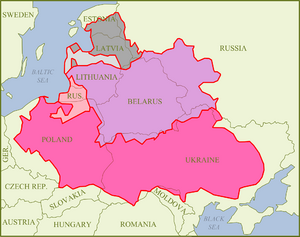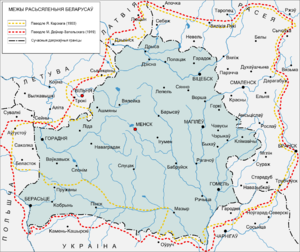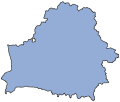Belarusians
| Cyril of Turaŭ • Euphrosyne of Polatsk • Francysk Skaryna • Leŭ Sapieha • Jan Czeczot • Kastuś Kalinoŭski • Vincent Dunin-Marcinkievič • Stanisłaŭ Bułak-Bałachovič • Ałaiza Paškievič • Janka Kupała • Jakub Kołas • Branisłaŭ Taraškievič • Piatro Mašera • Paveł Suchi • Maksim Tank • Volha Korbut | |||||||||||||||||||||||||||||||||||||||||||||||||||
| Total population | |||||||||||||||||||||||||||||||||||||||||||||||||||
|---|---|---|---|---|---|---|---|---|---|---|---|---|---|---|---|---|---|---|---|---|---|---|---|---|---|---|---|---|---|---|---|---|---|---|---|---|---|---|---|---|---|---|---|---|---|---|---|---|---|---|---|
| 10,582,247 | |||||||||||||||||||||||||||||||||||||||||||||||||||
| Regions with significant populations | |||||||||||||||||||||||||||||||||||||||||||||||||||
|
|||||||||||||||||||||||||||||||||||||||||||||||||||
| Languages | |||||||||||||||||||||||||||||||||||||||||||||||||||
| Religion | |||||||||||||||||||||||||||||||||||||||||||||||||||
|
Russian Orthodox Church, Minority Roman Catholics and Greek Catholics[12] |
|||||||||||||||||||||||||||||||||||||||||||||||||||
| Related ethnic groups | |||||||||||||||||||||||||||||||||||||||||||||||||||
|
Other Slavic peoples, especially Poles, Ukrainians, Rusyns |
Belarusians (Belarussians, Belorussians, Byelorussians) (in Belarusian: Беларусы; Russian: Белорусы) are an East Slavic ethnic group who populate the majority of the Republic of Belarus. Introduced to the world as a new state in the early 1990s, the Republic of Belarus brought with it the notion of a re-emerging Belarusian ethnicity, drawn upon the lines of the Belarusian language. There are over 8 million people who associate themselves with the Belarusian ethnicity today.
Contents |
Location
Belarusians also form minorities in neighboring Poland (especially in the former Belastok Voblast of BSSR), Russia and Lithuania. At the beginning of 20th century Belarusians constituted a majority in the regions around Smolensk.
Noticeable numbers have immigrated to the United States, Brazil and Canada in the early 20th century. During Soviet times, many Belarusians were deported or migrated to various regions of the USSR, including Siberia, Kazakhstan and Ukraine.
Since the breakup of the USSR several hundred thousand have immigrated to the European Union, United States, Canada and Russia.
See also Belarusian diaspora
Language
The most spoken language in Belarus is Russian, principally spoken by 72% of the population, while the other official language, Belarusian, is only used by 11,9%[13] in every day life. Statistical data shows that Belarusian is fluently communicated, read and written by 29,4%, while 52,5% of the population can communicate and read in Belarusian.[13] Belarusian is a language of the Eastern Slavic group with significant influence of Baltic and later Polish languages.
Genetics
Belarusians show the characteristic R1a genes of the male ancestorship at 51%. Such large frequencies of R1a has been found only in East Europe and India.[14]
Name
The name Belarus translates as White Ruthenia that is a historical region in the east of modern Republic of Belarus, known in latin as Ruthenia Alba. This name was in use in the West for some time in history, together with White Ruthenes, White Russians (though not to be confused with the political group of White Russians that opposed the Bolsheviks during the Russian Civil War) and similar forms. Belarusians trace their name back to the people of Rus'[.

History
The Belarusian people trace their distinct culture to the Grand Duchy of Lithuania and earlier Kievan Rus and the Principality of Polatsk. Most Belarusians are descendants of the East Slav tribes Dregovichs, Krivichs and Radimichs, as well as of Baltic tribe in the west and north-west of today's Belarus Yotvingians.[15]
In 13th-18th centuries Belarusians were mostly known under the name of Ruthenians which refers to the Eastern part of state of the Grand Duchy of Lithuania (Litva, Vialikaja Litva) of which the White Ruthenian, Black Ruthenian and Polesian lands were part of since the 13th-14th centuries and where Ruthenian language (also referred to as Old Belarusian language) was the chancellery language.
On the grounds of the dominance of Ruthenian language (which later evolved into modern Belarusian and and Ukrainian Languages) culture in the Eastern parts of the Grand Duchy of Lithuania, some modern Belarusian scholars suggest that Grand Duchy of Lithuania was partly a Ruthenian state when it existed.
After World War I Belarusians revived their own statehood, with varying degrees of independence - first as the short-lived Belarusian National Republic under German occupation, then as the Byelorussian SSR from 1919 until 1991, which merged with other republics to become a constituent member of the Soviet Union in 1922). Belarus gained full independence with the dissolution of the Soviet Union in 1991.

Cuisine
See Belarusian cuisine
See also
- Belarusian diaspora
- Belarusian language
- Black Ruthenia
- Demographics of Belarus
- Dregovichs
- History of Belarus
- Krivich
- List of Belarusians (ethnic group)
- Litvins
- Radimichs
- White Ruthenia
References and notes
- ↑ 1999 census
- ↑ 2002 census
- ↑ 3.0 3.1 3.2 3.3 3.4 3.5 3.6 http://www.belarustime.ru/belarus/culture/diaspore/c6420f28d9870602.html
- ↑ 2001 census
- ↑ 1999 census
- ↑ PMLP.gov.lv
- ↑ Multiculturalcanada.ca
- ↑ 8.0 8.1 2002 census
- ↑ 2001 census
- ↑ 2000 census
- ↑ http://www.armenia-new.belembassy.org/rus/soot/
- ↑ CIA - The World Factbook -- Belarus -- People -- Religions -- 1997 Census
- ↑ 13.0 13.1 Belta.by
- ↑ Doron M. Behar, Mark G. Thomas, Karl Skorecki, Michael F. Hammer, Ekaterina Bulygina, Dror Rosengarten, Abigail L. Jones, Karen Held, Vivian Moses, David Goldstein, Neil Bradman, and Michael E. Weale, "Multiple Origins of Ashkenazi Levites: Y Chromosome Evidence for Both Near Eastern and European Ancestries," American Journal of Human Genetics 73:768–779, 2003.
- ↑ http://www.krugosvet.ru/enc/istoriya/BELORUSI.html Энциклопедия Кругосвет
External links
- Ethnographic Map (New York, 1953)
- CIA World Fact Book 2005
- "ЧТО ТАКОЕ БЫТЬ БЕЛОРУСОМ?", ("What does it mean to be a Belarusian? ") a 2009 survey (Russian)
|
|||||||||||||||||||||||||

